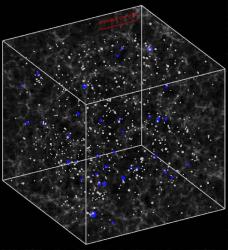 Astronomers have taken 4,000 of the brightest quasars and figured out just how much dark matter surrounds them. As we’re starting to learn, wherever there’s matter, there’s 10x as much dark matter. These quasars back that theory up.
Astronomers have taken 4,000 of the brightest quasars and figured out just how much dark matter surrounds them. As we’re starting to learn, wherever there’s matter, there’s 10x as much dark matter. These quasars back that theory up.
The survey was done using the Sloan Digital Sky Survey (SDSS-II); a detailed data set that will eventually contain more than 25% of the sky. Astronomers are continuously poring through this data, and finding nuggets of information for their theories.
With this latest research, a team of astronomers led by Yue Shen from Princeton University determined the position of 4,000 bright quasars. Quasars are some of the brightest objects in the Universe, and they’re thought to be the radiation emitted by actively feeding supermassive black holes at the hearts of distant galaxies. They’re so bright, they can be seen from billions of light-years away, at a time when the Universe was only a few billion years old.
Since dark matter is invisible, how can astronomers calculate the amount around a quasar? Through gravity. Although astronomers can’t see the dark matter, they can detect its influence on surrounding material, in this case, the quasars.
The researchers developed models of how the quasars should cluster depending on the amount of dark matter that surrounds them. And this latest survey matched their models. This clustering of dark matter might have provided the gravity that helped these supermassive black holes acquire their material in the first place, and helped them grow with the galaxies that surround them.
Original Source: SDSS News Release
